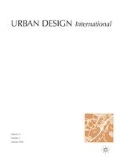Abstract
This article provides an overview of planning policy, practice, and theory related to downtown pedestrian malls in the US from the 1960s to present day taking into account social, economic, and design issues. It attempts to explain why most pedestrian malls failed and to recount the history of Santa Monica's downtown pedestrian mall. The story of this pedestrian mall is particularly interesting because the original mall, built in the 1960s, was a complete failure. Subsequently, the mall was entirely redeveloped in the 1980s and became a nationally recognized success. As interest in planning downtown pedestrian areas and alternative transportation modes has recently revived in the US, an explanation of the forces behind this turnaround is particularly illuminating.









Similar content being viewed by others
Notes
‘Downtown pedestrian malls’ are the American equivalent of the European car-free city centres. Usually at the beginning, they were exclusively commercial, with no mixed-uses, replicating suburban shopping malls. Hence the term downtown pedestrian ‘malls’.
References
Arroyo Group/Studio Works. (1980) 3rd Street Mall. A Design and Revitalization Plan for the Santa Monica Mall. Santa Monica: Arroyo Group/Studio Works.
Bayside District Corporation. (2004) Demographics. Downtown Santa Monica and Third Street Promenade, available online at: http://www.downtownsm.com/bbayside_media_demo.html, accessed on 10 April 2005.
Bednar, M.J. (1989) Interior Pedestrian Places. New York: Watson-Guntill Publications.
Blaha, D. (2003) City of Buffalo Main Street Multi-Modal Access and Revitalization Project. Final Environmental Assessment. New York DOT: Buffalo Place, photocopied.
Brambilla, R. and Longo, G. (1977) For Pedestrians Only. Planning, Design, and Management of Traffic-Free Zones. New York: Whitney Library of Design.
Branaugh, M. (2002) More pedestrian malls fail than succeed, observers say, in The Daily Camera and the E.W. Scripps Company, available online at: http://web.dailycamera.com/pearl/19xwor.html, accessed on 9 February 2005.
Breines, S. and Dean, W.J. (1974) The Pedestrian Revolution. Streets without Cars. New York: Vintage Books Edition.
CIC Research, Inc. (2003) Results from the Downtown Santa Monica Area Household Telephone Surveys and Intercepted Visitor Surveys. Santa Monica: Bayside District Corporation, available online at: www.thirdstreetpromenade.com/pdf/bayside_demographics.pdf, accessed on 10 April 2005.
CIC Research, Inc. (2006) A Study of Visitors to the Downtown Santa Monica Area. Santa Monica: Bayside District Corporation, available online at: http://www.downtownsm.com/pdf/Bayside_Report_2006.pdf, accessed on 26 August 2007.
City of Ithaca. (2005) Downtown/the commons, available online at: http://www.ci.ithaca.ny.us/index.asp?Type=B_BASIC&SEC=\{4519B3DC-DFAD-47EE-9E0A-6A55E243E4B4\}&DE=\{6A5CE5FD-C601-43F0-9E6B-EF2D12703779\} accessed on 9 February 2005.
City of Santa Monica. (1991) Third Street Promenade Outdoor Dining Standards. Santa Monica: Policy and Planning Analysis Division, Planning and Community Development Department.
City of Santa Monica. (1996) Bayside District Specific Plan. Santa Monica: Policy and Planning Analysis Division, Planning and Community Development Department.
Downtown Denver Business Improvement District. (2004) 16th Street Mall, available online at: http://www.downtowndenver.com/bid/16thstmall.htm, accessed on 9 February 2005.
Fruin, J.J. 1971 Pedestrian Planning and Design. New York: Metropolitan Association of Urban Designers and Environmental Planners.
Great Streets. (2003) Charlottesville Virginia. East Main Pedestrian Mall, available online at: http://www.greatstreets.org/MainStreets/MainCharlottesville.html, accessed on 9 February 2005.
Hardwick, J.M. (2004) Mall Maker. Victor Gruen, Architect of an American Dream. Philadelphia: University of Pennsylvania Press.
Hoffman, P. Vice Chair of Bayside District Board (2005). Interview by author, 25 March, Santa Monica.
Kaplan, E. ex-president of Bayside District Corporation (2005). Interview by author, 25 March, Santa Monica.
Local Government Commission. (1998) Moving to Main Street, New Street Guidelines Available, in Livable Places Update, available online at: http://www.lgc.org/freepub/PDF/Land_Use/lpu/lpu_9810.pdf, accessed on 9 February 2005.
McGuigan, M. (2003a) Pedestrian's paradise, in The Lookout, available online at: www.surfsantamonica.com/ssm_site/the_lookout/news/News-2003/Nov-2003/11_07_03_Pedestrians_Paradise.htm, accessed on 2 April 2005.
McGuigan, M. (2003b) Paradise lost and regained, in The Lookout, available online at: www.surfsantamonica.com/ssm_site/the_lookout/news/News-2003/Nov-2003/12_11_03_Paradise_Lost_And_Regained.htm, accessed on 2 April 2005.
Rawson, K. executive director of Bayside District Corporation (2005). Interview by author, 28 March, Santa Monica.
Rawson, K. executive director of Bayside District Corporation (2007). Interview by author, 1 August.
Resnick, R. ex-president of Bayside District Corporation (2005). Interview by author, 28 March, Santa Monica.
Robertson, K.A. (1994) Pedestrian Malls and Skyways. Brookfield VT: Avebury.
Rubenstein, H.M. (1992) Pedestrian Malls, Streetscapes, and Urban Spaces. New York: John Wiley & Sons, Inc.
Third Street Development Corporation and City of Santa Monica. (1986) Third Street Mall Specific Plan (August 12, 1986). Santa Monica: Third Street Development Corporation and City of Santa Monica.
Van Tillburg, J. Bayside District Board member (2005). Interview by author, 25 March, Santa Monica.
Warfel, J. Vice Chair of Bayside District Board (2005). Interview by author, 24 March, Santa Monica.
West, A.B. (1995) An Information Brief on Downtown Pedestrian Malls. Washington DC: National Main Street Center, available online at: www.ci.buffalo.ny.uc/Files/1_2_1/our_city/Info%20Downtown%20Ped%20Malls.pdf accessed on 31 January 2005.
Zane, D. ex-mayor of Santa Monica (2005). Interview by author, 24 March, Santa Monica.
Acknowledgements
The author is grateful for the help of numerous individuals in Santa Monica who went to great efforts to provide extensive information on the history and operation of their Promenade. Special thanks are owed to Ken Baar.
Author information
Authors and Affiliations
Corresponding author
Rights and permissions
About this article
Cite this article
Pojani, D. Santa Monica's Third Street Promenade: the failure and resurgence of a downtown pedestrian mall. Urban Des Int 13, 141–155 (2008). https://doi.org/10.1057/udi.2008.8
Published:
Issue Date:
DOI: https://doi.org/10.1057/udi.2008.8




